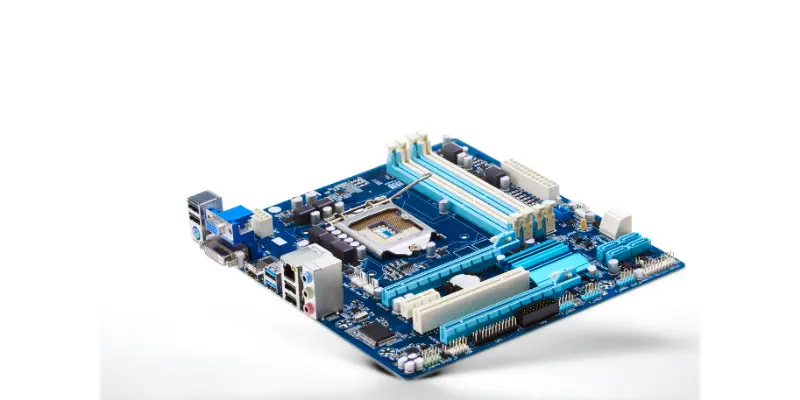Disclaimer: This post may contain affiliate links, meaning we get a small commission if you make a purchase through our links, at no cost to you. For more information, please visit our Disclaimer Page.
The computer motherboard is a circuit panel that links everything in the personal computers. It also connects to the processor and the computer’s central memory systems. This is the primary system (the brain) where everything about your computer takes place.
It also comes with some add-ons like the mouse, external keyboard, and USB system that support the general functionality of the PC. For this to effectively work, the motherboard needs specific drivers compatible with the system.
Most drivers come with an Operating System so that you will get them upon installation. However, they need a constant upgrade to stay abreast with the changes in the industry. So how do you ensure that?
Your PC will always send you notifications on the driver updates. You can also go to the specific motherboard manufacturer’s website and check under the support option for drivers and utilities. Compare the latest versions to the drivers you have on your PC.
The article below discusses various concepts that you need to know about installing and updating your motherboard drivers. After reading it, you will understand how to do it and why it is important.
Table of Contents
How Do You Make Sure All Your Drivers Are Up to Date?
The built-in Windows update service on your OS generally keeps most of your drivers up to date. So unless you are using a niche device that doesn’t provide updates via the Windows update, you most of the time don’t have to worry about keeping your drivers up to date.
However, it is important to ensure that your system runs on the latest drivers for optimum effectiveness. You can also opt to update the drivers when you want to do something extra, like installing a new game or when you notice your hardware becoming too slow.
Do You Need to Update Motherboard Drivers?
Without the drivers, your computer motherboard is merely a system of electrical components put together. Boost your security features. Broken or outdated motherboard drivers are a major cause of security loopholes, making your PC vulnerable to cybercriminals and malicious software. Most OS manufacturers release security updates from time to time, trying to seal these gaps.
Running your system on updated drivers is much safer. It eliminates chances of exposure to potential threats protecting you at both personal and business levels.
Boost Your Slow PC
When your drivers begin to get obsolete, your computer will get slower in specific instances, such as when you start. It may also start to reboot when in use. After some time, some drivers become outdated and may not be compatible with various devices you have installed on your computer. As a result, you experience sluggish performance since the driver will fail to interpret some data so that the components can comprehend.
Some programs, especially audio and video data that need processing, may also slow down with outdated drivers. For gamers, running on damaged or outdated motherboard drivers can reduce game speed and interfere with your experience’s thrill. To avoid that and boost your productivity, ensure that you update your motherboard drivers as often as possible.
Increase Your Hardware Efficiency
Most hardware issues result from motherboard driver problems. Some hardware components may fail to work properly with outdated drivers. Some may not work at all. Brocken drivers can result to the following hardware issues;
Webcam Problems
The webcam is a critical component that supports video chats and video calls on various platforms. However, a dysfunctional one leads to a major disappointment, especially when you need the camera for some important tasks. Unfortunately, with outdated motherboard drivers, dysfunctional webcams are inevitable.
Incompatibility with Windows USB Mouse
Outdated motherboard drivers will handicap the primary functionalities of your computers, including the mouse and USB recognition. If your computer operates on broken or outdated drivers, it may fail to recognize the various hardware that needs coordination.
Monitor and Display problems
A computer is as functional as its display. With dysfunctional and outdated drivers, you will keep experiencing display problems such as the blue screen.
All these three issues only have one solution, constant driver updates. When you do that, you will increase the compatibility and efficiency with which the hardware works.
How Do You Know If Your Motherboard Needs Updating?
Motherboard drivers allow your computer OS and other applications to connect with the hardware system. The most practical example is that your PC cannot independently use all the video card features. As such, it needs assistance from specific drivers to work effectively.
You cannot use a printer, mouse, camera, or any other hardware without installing the drivers. Drivers, like all other computer programs, need contestant updates. So how do you know when this is due? Find out here;
When Your PC Notifies You
Your computer will always give you notifications on pending updates. For example, you will get notifications regarding your computer’s security threats associated with your driver version. Based on the potential threat and your assessment, you might choose to update your drivers to solve the issue.
Your computer will also give you notifications whenever updates for your hardware components like mouse or keyboard. It is better to install the updates as soon as they pop up.
When You Have Corrupted Drivers
Your drivers may miss or get corrupted because of various reasons, including invalid operation, virus, and malware invasion. When this happens, the external hardware you attach to the computer may fail to function properly.
In such cases, you will need to reinstall the drivers for your devices to regain their functionality. You can always check your driver status on the Device Manager. A missing or corrupted driver will have a yellow mark next to it.
When You Want to Install a New Game
Hardware manufacturers always update their drivers for every game they release, meaning that the new version may not be compatible with your old drivers. Updating your driver version ensures that you stay ahead with the changes and enhance your performance with every release.
Right-click on the driver with the yellow mark, then click ‘Update Driver Software.’
When Your Computer has Hardware Issues
Some hardware problems result from outdated drivers. So in case you encounter such, you need to update the drivers instead of replacing the hardware component.
For example, a problem with your sound system may not necessarily mean that you have to replace the speakers. Sometimes the sound card drivers may be faulty. The preliminary solution to this would be downloading and installing the latest drivers compatible with the system.
When You Are Upgrading to Features that the Existing Driver Version Does Not Support
When you want hardware with some features, there are cases that the drivers that come with your OS do not support. Sometimes the drivers might support the hardware but not all its features.
In such cases upgrading your drivers to the newest versions can help you acquire the extra features your hardware needs. So before you disregard the hardware, try the upgrades first.
Can You Install Motherboard Drivers Without a CD?
While CD installation is the most common way to have new drivers installed on your computer, it is not the only way. For example, some laptops do not have the CR-ROM, making it difficult to use a CD on them. With such machines, you need to find a different way to install new motherboard drivers. Here is how to do it.
Method One: Manual Download and Installation from Manufacturer Site
You can always visit your official manufacturer’s website and download the available motherboard drivers. However, it is a bit of a manual approach where you do all the work.
Step One: Visit The Official Page
Visit the official website of the motherboard manufacturer, then key in the exact motherboard model you want to install.
Step Two: Download the Specific Model
The system will take you to the driver download page, where you will then select the exact latest drivers for your motherboard. Ensure that you download drivers for every component on the motherboard.
To do this, you will need to know all the systems that run on your computer. For example, the type of the windows and whether your computer is 32-bit or 64-bit. The knowledge will help you get a suitable driver for your variant system
Step Three: Install the New Drivers
Once the download completes, open the file and follow the prompts as they appear on your screen. Once you complete this, your drivers will be functional and running effectively.
Method Two: Install The Drivers from A Flash Drive
Installing motherboard drivers from a flash drive is pretty easy, requiring little skills. The method is helpful if you do not have an optical drive or internet connection.
All you need to do is have sources from the drivers elsewhere and store them on the flash drive before starting with the installation process. There are three ways to do this: Find an internet source and download the drivers, copy the installation from a CD or get them from another computer with the same specs.
In the first step, you will have to find the right drivers from the manufacturer sites (steps in Method one), save them in your USB drive then install them. After that, you can download the drivers to another computer then transfer them for use on your machine.
You can even use a friend’s computer or visit a cyber café to download and save the setup file on your USB drive. However, you must know the exact specs for your machine before you can download them.
In the second method, you can get a CD from a friend or any other source then copy the drivers on your USB drive. After that, you will insert the flash drive into your USB port, open the file and run the drivers on your PC. Here you must also be keen to get the exact drivers that are compatible with your PC.
Suppose you are installing drivers for a different PC with the same specs; you do not have to download drivers in each of them. Instead, download it in one machine, then copy the files in your USB drive for use in the other machines. It saves you time, effort, and bundles (if you are using metered internet).
You can proceed to install your drivers once you have them on your flash drive. Here is how to do it:
Step One: Locate the File
Most downloaded drivers will come in the form of zipped folders. So you will need to access the location where you stored it, then right-click on the folder. After that, select ‘extract here’ to unzip the directory. You can use the WinRAR application or Windows unzip tool to extract the files.
Step Two: Access The Setup File
Open the unzipped folder, then double click on the Setup file (.EXE file) to initiate the setup process.
Step Three: Follow The Instructions
Now follow the prompts as they appear on your screen. The first prompt will ask you to accept the manufacturer license agreement before getting to the drivers’ installation. The setup process may vary depending on your PC and type of driver, but the process is the same.
Click on Accept button and then the install button to begin installing the drivers. When the installation completes, it is important to restart your PC to make the drivers work properly.
There are also other means to install new motherboard drivers without using a CD. For example, if you have another computer with the same driver you want, transfer them with other software like Dukto, save the drivers in your computer then use the above process to install them.
How Do You Update Your Motherboard Drivers?
Installing motherboard drivers isn’t the end of everything. The drivers need constant updates, which you must do for your PC to function properly. The methods vary from easy to complex, depending on your skills. Here are some that you can use;
Method One: Use Bit Driver Update
You may not have the patience or the skill to navigate through the various windows looking for driver update icons. In such cases, automatic motherboard driver updates through Bit Driver can be your best option.
Step One: Download the Bit Driver Software
Go to your browser, download the Bit driver setup and run it to install.
Step Two: Scan for Available Updates
Use the software to scan your computer for outdated drivers.
Step Three: Install the Updates
After completing the scan, you will have two options: update everything at once or select every item separately. You can do the former with the free version, but you will have to upgrade your subscription to the pro package for the ‘Update-All’ option.
Method Two: Use Windows Updates
You get new, updated windows drivers every time you perform you update your Windows. It comes with double benefits because you accomplish two things with a single process. Here is how to do it.
Step One: Launch the Settings
Simultaneously press the windows, and I key to launch the ‘Settings’ window. You can also do this by typing ‘settings’ on the search on the bottom left corner of your taskbar.
Step Two: Update the System
Once your setting window appears, click on the Updates and Securities icon. It will take you to the next window, where you will then select the ‘Check for Updates’ icon.
Step Three: Wait
After selecting that, the system will automatically download the available updates. All you have to do is wait. You may have to restart your computer after the download and installation.
Method Two: Automatic Update
Sometimes you do not have the patience and skills to manoeuvre through the browser, keying in figures and downloading drivers. In that case, you can capitalize on shortcuts like Driver Easy.
Apart from being an easy option, the software saves time by eliminating any possibilities of downloading and installing the wrong drivers. Here is how to automatically update motherboard drivers.
Step One: Install Driver Easy
First, you have to download the Drivers Easy software. Go to your browser, search for Driver Easy then download the free version.
Step Two: Scan Your Computer for Driver Issues
Open the newly installed Driver Easy software and Click the ‘Scan Now’ button. The software will automatically scan your computer and detect any issues with the drivers.
Step Three: Update the drivers
The system will display the number of updates available for your computer. All you need to do here is click on the update button beside the respective driver. The download is automatic, but you will have to install the new version manually.
If you installed Driver Easy pro, you could click the ‘Update All’ button on the bottom right side of the window; doing this updates all the drivers automatically in your device. If you are using the free version, the software will prompt you to upgrade your subscription before doing this.
Method Three: Use The Uninstall Option
You can also uninstall a motherboard driver and reinstall it. Here is a step-by-step procedure on how to do it;
Step One: Search for Device Manager
Locate the search box on the taskbar, then type ‘Device Manager,’ then Click on the ‘Best Match.’
Step Two: Locate the Processor Icon
On the device manager, locate the processor icon and click on the arrow on its left. It will expand with four Intel R icons.
Step Three: Select the Changes You Want
Right-click on the first icon, then click on ‘Uninstall device’ and confirm your action by clicking ‘Uninstall’ again.
Step Four: Restart to Install Again
After the uninstallation, restart your computer; use step two above to reinstall the motherboard drivers.
Method Two: Use The Device Manage
The second way to install the latest motherboard drivers for your computer is through its built-in utility, the Device Manager. Here is a simplified process on how to do it:
Step One: Search for Device Manager
Locate the search box on the taskbar, then type ‘Device Manager,’ then Click on the ‘Best Match.’
Step Two: Locate the Processor Icon
On the device manager, locate the processor icon, then click on the arrow on its left. It will expand with four Intel R icons.
Step Three: Select the Changes You Want
Right-click on the first icon, then select ‘Update Drivers.’ On the next screen, click on ‘Browse my computer for updated driver software.’
Step Four: Save the Software
Select the folder where you want to store the driver software – you will have to select different checkmarks, including subfolders for the exact location. Then, select ‘Browse.’
Step Five: Complete the Installation
Once you complete the download process, follow the prompts as they come to install the new motherboard drivers.
Bottom Line
Your drivers are as important as any other components in the motherboard. Keeping up to date ensures that your system functions to the optimum level and you enjoy every step of using the computers.
There are various ways to ensure that, from the Windows OS own built-in auto-update services to third-party applications Bit Driver Software. There is no excuse for running your computers on outdated drivers.




